Substack alternatives: 9 platforms for newsletters and online publishing
 Substack home page - Image © Substack
Substack home page - Image © Substack
Substack has revolutionized the way independent writers and journalists monetize their work by allowing them to create and distribute written content. The platform gained significant attention for its simplicity and user-friendly interface, attracting established and new journalists and creators. Many prominent writers have migrated to Substack, drawn by the potential for financial independence and creative freedom.
Substack offers a range of tools and features to assist writers, including a built-in payment system, subscriber analytics, and the ability to customize the appearance and branding of newsletters.
However, it is certainly not the only platform of its kind, and there are several best Substack alternatives that offer similar features. Let’s take a closer look at some of the main alternatives to Substack and compare their features and capabilities. We’ll dive deep into various newsletter software products, so you can best determine what suits your individual needs. We’ll also include the pricing of each platform to help you find a solid alternative.
Introduction to Newsletter Platforms
Newsletter platforms have become an essential tool for content creators, writers, and businesses to reach their audience and monetize their content. With the rise of online publishing, many platforms have emerged to cater to the needs of creators. These platforms offer a range of features, from basic email marketing tools to advanced customization options, helping creators build a loyal audience and generate revenue. In this section, we will explore the world of newsletter platforms and what they have to offer.
What is a Substack Alternative?
A Substack alternative refers to a platform that offers similar features and functionality to Substack, but with its own unique twist and advantages. Substack is a popular platform for creators to publish and monetize their content, but it may not be the best fit for everyone. Alternative platforms can offer more flexibility, customization options, and advanced features that can help creators grow their audience and increase their revenue. Whether you’re looking for a minimalist interface, more advanced newsletter features, or better monetization options, there’s likely a Substack alternative that meets your needs.
Key Features of Newsletter Platforms
When it comes to choosing a newsletter platform, there are several key features to consider. Good publishing tools are essential as they enhance the user experience for creators, enabling them to effectively manage and monetize their content through blogging and newsletters. These features can make or break the success of a creator’s newsletter and ultimately, their business. Understanding these key features can help you select a platform that aligns with your goals and provides the tools you need to succeed.
Email Marketing Tools
Email marketing tools are a crucial component of any newsletter platform. These tools allow creators to create automation workflows and send targeted email campaigns to their subscribers, helping them to build a loyal audience and drive revenue. Some popular email marketing tools include automation workflows, segmentation, and personalization features. For example, platforms like Mailchimp and Kit offer advanced email marketing tools that can help creators optimize their campaigns and increase engagement. Many platforms like Mailchimp, Kit, and MailerLite also enable the use of customizable landing pages for email subscription management. These tools enable you to create custom flows, track email marketing campaigns, and deliver standalone newsletter subscriptions effectively.
Advanced Features of Newsletter Platforms
In addition to basic email marketing tools, many newsletter platforms offer advanced features that can help creators take their content to the next level. However, some platforms, like Revue, lack community-building features, which can hinder user engagement. These features can provide additional value to your audience and streamline your content creation process.
Customization Options
Customization options are essential for creators who want to stand out from the crowd and build a unique brand. A custom profile domain can significantly enhance user experience by allowing users to personalize their brand through unique domain names. These options can include custom themes, templates, and design elements that can be tailored to fit a creator’s style and voice. For instance, platforms like Ghost and Medium offer a range of customization options that can help creators create a professional-looking newsletter that reflects their brand. Additionally, some platforms like Beehiiv and Buttondown offer AI personalization features that can help creators tailor their content to their audience’s interests and preferences. By leveraging these customization options, you can craft sleek email campaigns that resonate with your audience and enhance your brand identity.
By considering these features and options, creators can choose a newsletter platform that meets their needs and helps them achieve their goals. Whether it’s building a loyal audience, increasing revenue, or creating a unique brand, the right newsletter platform can make all the difference.
Monetization Features of Newsletter Platforms
Newsletter platforms offer various monetization features to help creators earn revenue from their content. These features include paid subscriptions, membership management software, and advanced tools such as email marketing automation and segmentation. For instance, platforms like Kit and Mailchimp provide robust email marketing tools that allow creators to automate their email sequences, segment their audience, and personalize their messages. This can significantly enhance engagement and conversion rates.
Additionally, many platforms offer tools for managing affiliate relationships, enabling creators to earn commissions by promoting products or services. Custom flows for automation workflows are another key feature, allowing creators to set up complex sequences that nurture leads and convert them into paying subscribers. By leveraging these monetization features, creators can build a sustainable writing business and maximize their revenue potential.
Monetization Strategies
Effective monetization strategies for newsletter platforms include offering exclusive content to paying subscribers, delivering standalone newsletter subscriptions, and using relevant ad campaigns to generate revenue. For example, creators can provide premium content that is only accessible to subscribers who pay a monthly or annual fee. This not only incentivizes subscriptions but also fosters a sense of exclusivity and value.
Using membership management software, creators can automatically collect recurring payments and manage their membership programs efficiently. This software often includes features like AI personalization and drag-and-drop editing tools, which help creators craft sleek email campaigns and publish high-quality content. Additionally, running relevant ad campaigns within newsletters can be a lucrative revenue stream, especially when the ads are well-targeted and resonate with the audience.
SEO Features and Optimization
SEO features and optimization are crucial for newsletter platforms to increase visibility and reach a wider audience. Platforms that offer SEO features such as customizable landing pages, website features, and advanced analytics can help creators optimize their content for search engines. For instance, having customizable landing pages allows creators to tailor their pages to specific keywords and improve their search engine rankings.
Some platforms also provide education and training materials to help creators improve their SEO skills and create more effective online marketing campaigns. These resources can be invaluable for creators who are new to SEO or looking to refine their strategies. By leveraging these SEO features, creators can enhance their online presence and attract more subscribers.
SEO Features for Newsletter Platforms
SEO features for newsletter platforms include customizable templates, drag-and-drop editing tools, and advanced analytics to track email marketing campaigns. Platforms like Mailchimp and Kit offer robust analytics that allow creators to monitor the performance of their campaigns and make data-driven decisions. Social media integration is another valuable feature, enabling creators to share their content across multiple channels and increase their reach.
Additionally, some platforms provide unique tools like education-themed clip art and writing platform features that help creators optimize their content for search engines. By using these tools, creators can ensure their newsletters are not only engaging but also SEO-friendly. This can lead to higher search engine rankings, more traffic, and ultimately, more subscribers.
Ghost - great for blogging
One alternative to Substack is Ghost, an open-source publishing platform. Ghost is similar to Substack in that it allows users to create and publish content, but it includes additional features that Substack is missing that might make it an appealing option for more established independent bloggers or small publications. Additionally, Ghost does not charge transaction fees on subscriptions, allowing creators to keep all their revenue.
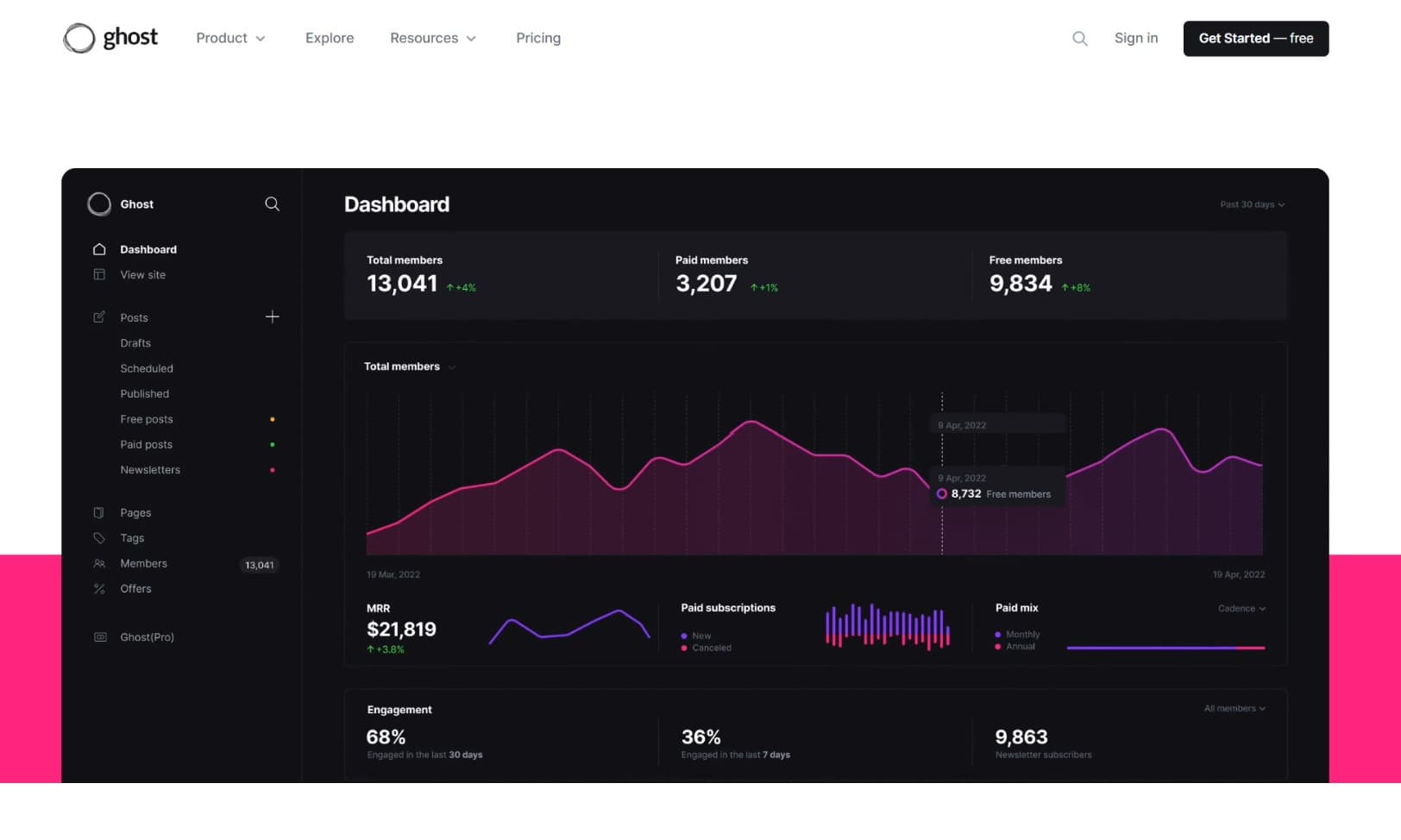 The ghost.org home page © Ghost
The ghost.org home page © Ghost
One of the main differences between Ghost and Substack is the level of control users have over their content. Ghost lets users do more ‘heavy lifting’ when it comes to customization, offering custom themes and templates to fully edit the look and feel of their publications, while Substack has a more limited set of options. Ghost also offers multi-author support, which allows multiple users to contribute to a single blog or website, making it a good option for teams. Additionally, Ghost provides the ability to mix traditional blogging with paid newsletters, offering creators a versatile platform to engage their audience and monetize their content.
What is Ghost's pricing model?
Ghost costs from $11/month or $108/year for the Starter plan, including one staff user, free Ghost website themes and standard built-in integrations, and a maximum of 500 members. There are three higher tiers starting with the Creator plan at $25/month for 1,000 Members and extra functionality such as custom integrations.
Medium - great for community publishing
Medium is another platform that offers features similar to Substack. It’s a blogging and writing platform that allows users to share stories, and it has a large community of readers and writers. Medium is known for its clean, easy-to-use interface, and its emphasis on quality content. It encourages readers to discover stories, thinking, and expertise on any topic.
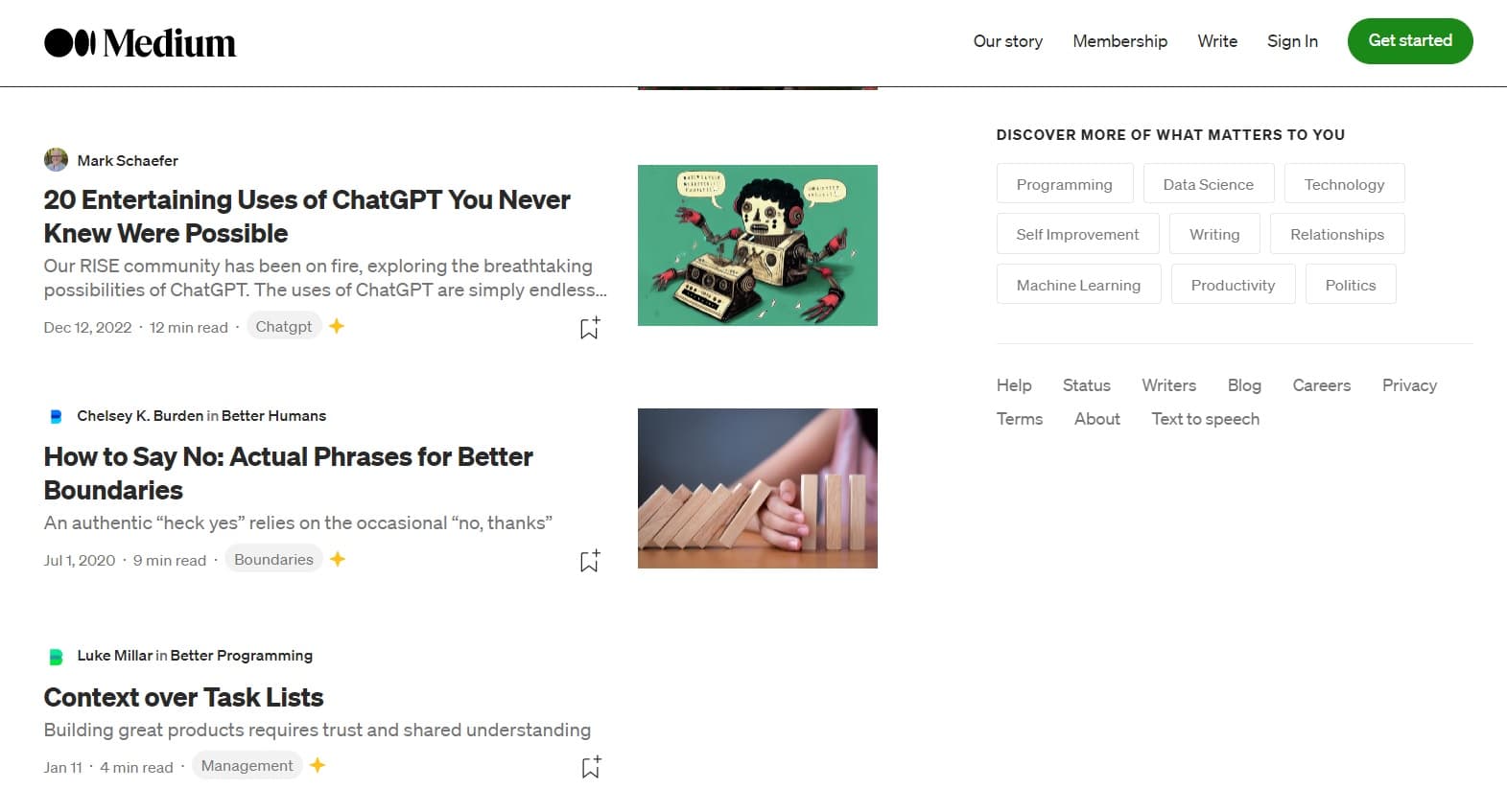 The medium.com home page © Medium
The medium.com home page © Medium
Medium is an ideal platform for writers and journalists looking to reach an engaged audience, and so easily qualifies as one of Substack’s top competitors, as it has a loyal built-in community of readers – but the readership is focussed online or on the app, not in email newsletters. Medium’s membership program and paywall options allow writers to monetize their content, making it a versatile membership platform. Moreover, Medium is completely free to publish for writers.
What is Medium's pricing model?
There’s no cost at all to publish on Medium, for any number of members/subscribers you may have. Medium makes its money by charging people to read your stories and other people’s stories, at $5/month or $50/year.
In fact, writers on the Medium Partner Program can earn money through referrals. Successful referrals bring in half of a new member’s subscription fee for as long as they remain a paying member, minus the standard 2.9% + $0.30 in payment processing fees. So, if you got 100 readers to sign up for a monthly Medium membership, you’d receive $227 per month.
Kit - great for automation
Kit (formerly ConvertKit) is an email marketing and automation platform designed for creators such as bloggers, journalists and podcasters. It helps content creators monetize by providing features like Stripe integration for paid newsletters. It’s designed to help users build an email list, automate email sequences, and segment audiences for targeted marketing. Kit offers functionality such as opt-in forms, landing pages, and email comms like other Substack alternatives.
 The kit.com home page © Kit
The kit.com home page © Kit
One of the main focuses of Kit is to automate the process of connecting with new potential subscribers and nurturing them into customers. It also has a visual automation builder which allows you to create complex automation flows without coding. It also includes tools for managing affiliate relationships and providing exclusive content to paying subscribers. Kit offers visual automation builders that help users nurture their audience effectively.
What is Kit's pricing model?
For new creators, Kit is free for up to 300 subscribers. For creators with growing audiences, Kit costs from $15/month or $108/year, again for up to 300 subscribers, but also with access to email sequences, automation builders and third-party integrations plus an additional team member.
MailChimp - great for email
MailChimp is an email marketing service that allows businesses and organizations to create and send email campaigns to (often large) audiences. As one of the largest email marketing services, Mailchimp offers the ability to create custom email templates, segment and target your audience, track the performance of your campaigns, and integrate with a variety of other tools and services to replicate a Substack competitor. MailerLite offers customizable templates and automation tools for sending targeted emails. Similarly, Campaign Monitor provides powerful analytics and personalization features for email marketing, enabling creators to optimize their campaigns and better connect with their audience.
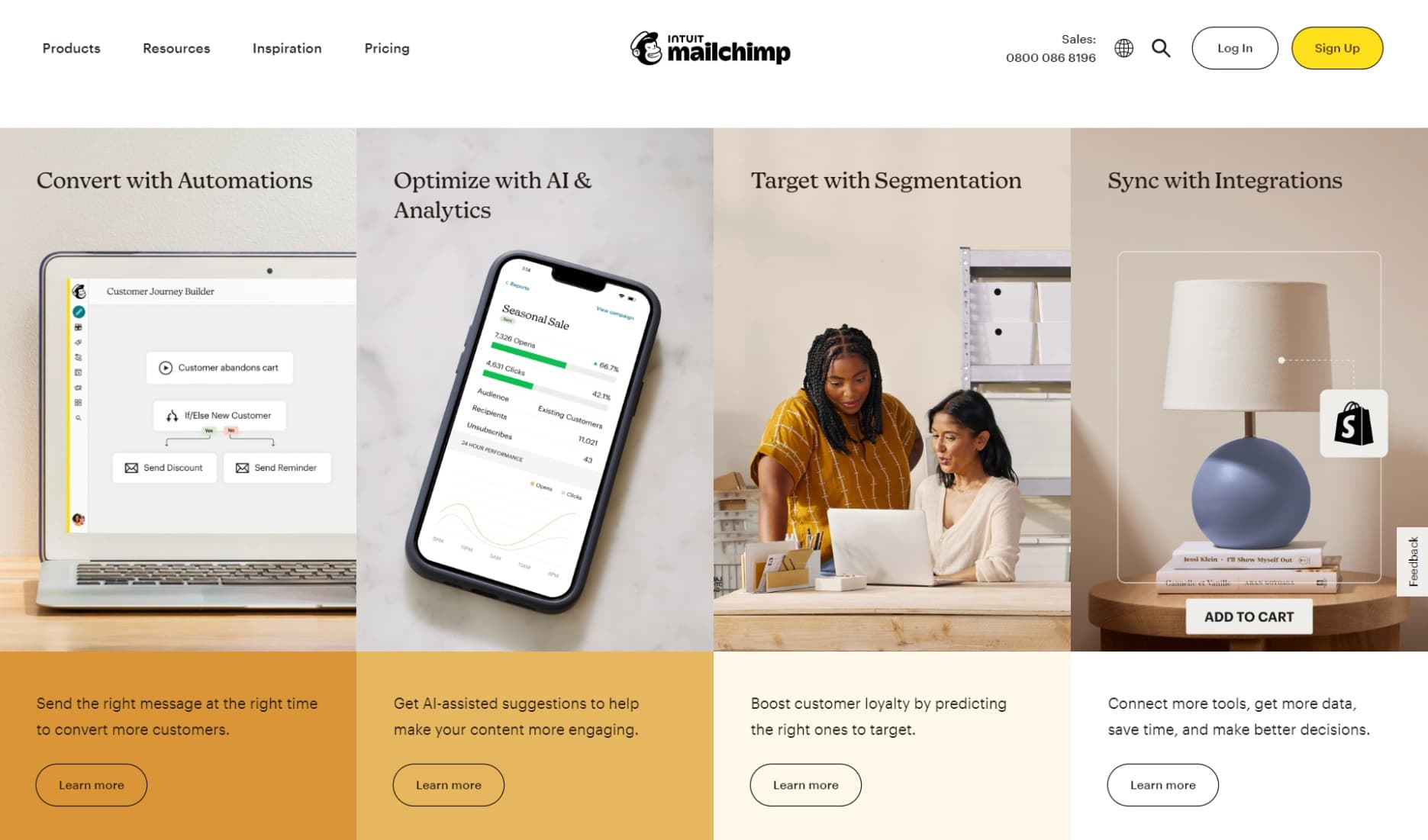 The mailchimp.com home page © Mailchimp
The mailchimp.com home page © Mailchimp
With Mailchimp, you receive analytics and tracking tools to help you understand how your campaigns are performing and make data-driven decisions. It’s less focussed on publishing and more for email CRM or ecommerce; as such it provides integrations with website builders, e-commerce platforms, and other tools that automate creating and sending email campaigns.
What is MailChimp's pricing model?
Mailchimp offers a free plan, which allows you to use most of the basic features for up to 2,500 email sends to up to 500 people with basic reporting. Paid plans for larger lists and more advanced features start from $20/month for up to 6000 sends to up to 500 people.
Patreon - great for creators
Patreon allows independent creators such as writers and musicians to receive financial support from their audience through a subscription service, to fund their work and continue to produce new content. Creators set up a page on the Patreon platform, and their fans, or “patrons,” can choose to support them with a regular monetary contribution. In return, patrons receive exclusive content and/or perks. Similarly, Mighty Networks helps creators engage members with features like live events and courses, fostering deeper connections and providing additional value to their communities.
 The patreon.com home page © Patreon
The patreon.com home page © Patreon
Patreon operates on a subscription model, so patrons are charged a set amount on a recurring basis (usually monthly). Creators can choose to offer different levels of support with different rewards for each level, so patrons can choose to contribute a little or a lot depending on their budget and the level of engagement they’re looking for. This allows for independent creators to continue producing content without being beholden to advertisers or traditional gatekeepers.
What is Patreon's pricing model?
Patreon Lite costs 5% of the monthly income you earn on Patreon, plus payment processing fees, and offers a creator page, communication tools and access to Patreon workshops. The Patreon Pro plan takes 8% of the monthly income you earn plus payment processing and offers in additional membership tiers, analytics and insights and a tool to run promotions.
SendFox - great for campaigns
SendFox is a free newsletter tool that allows users to create, send, and track email marketing campaigns. It provides a range of features including email templates, automation, segmentation, and analytics. Sendfox is designed for businesses of all sizes and can be used to promote products and services, grow customer relationships, and increase conversions.
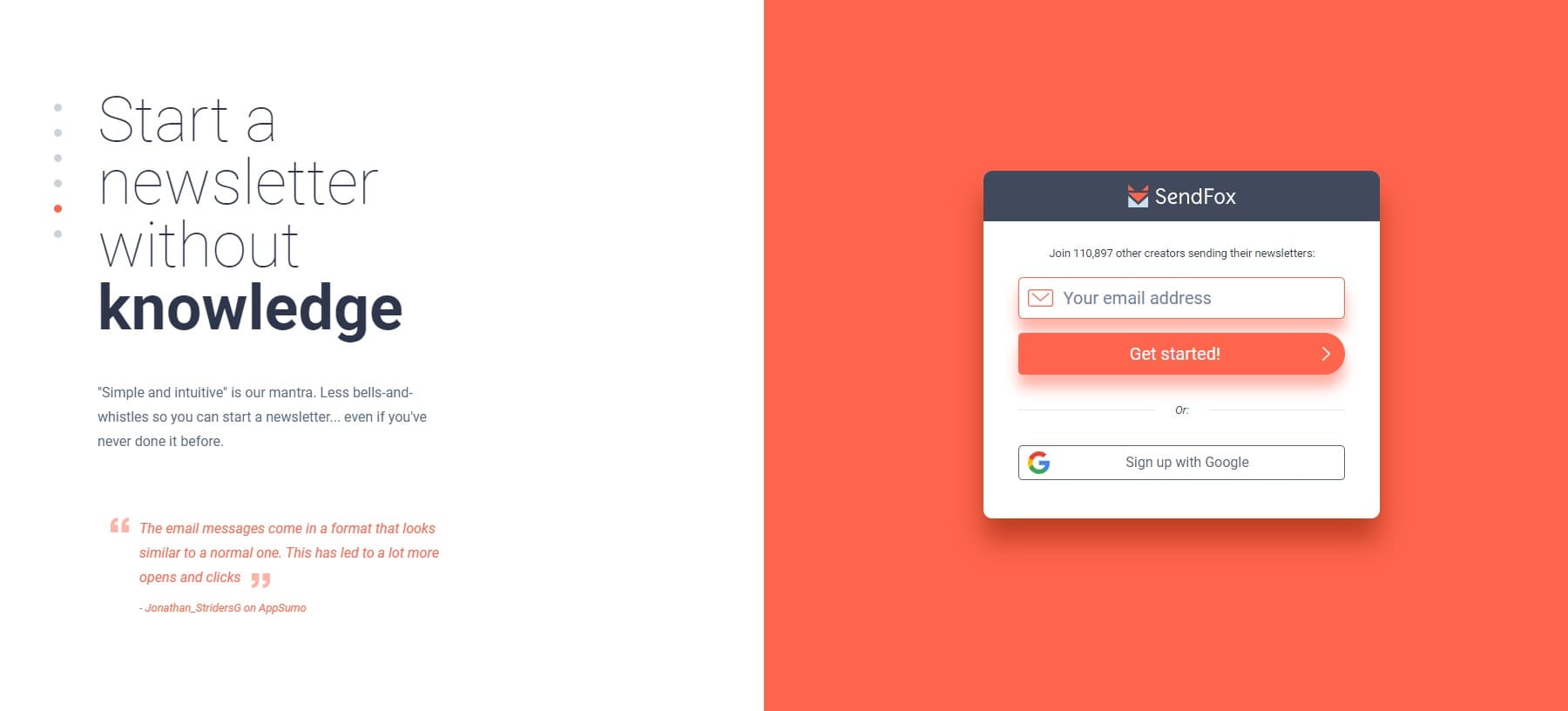 The sendfox.com home page © SendFox
The sendfox.com home page © SendFox
There’s a free version of SendFox which allows sending newsletters to 1000 contacts with SendFox-branded emails and no automations. The Lifetime Plan costs just one payment of $49 (not recurring) and allows up to 5000 members, reduced SendFox branding and unlimited automations. This could be the cheapest of all Substack competitors.
What is SendFox's pricing model?
The Sendfox free plan allows for unlimited sending to up to 1,000 members but emails have SendFox branding. The Lifetime Plan costs just $49 for a single payment - that’s currently down from $480 – and allows up to 5,000 members and improved deliverability.
Beehiiv - great for scale and newsletter platform
Beehiiv is a newsletter and website platform for writing, monetizing, and distributing newsletters. Beehiiv’s founder Tyler Denk believes that while social media may have been where writers and creators established their names, email remains the most lucrative channel for audience building. The network powers over 7,500 active newsletters. Beehiiv is designed for managing newsletters and includes AI personalization tools. It also allows users to grow their email lists quickly using audience segmentation and performance metrics. Additionally, Beehiiv supports community-led growth, which can lead to a more sustainable business model for creators by fostering stronger connections with their audience.
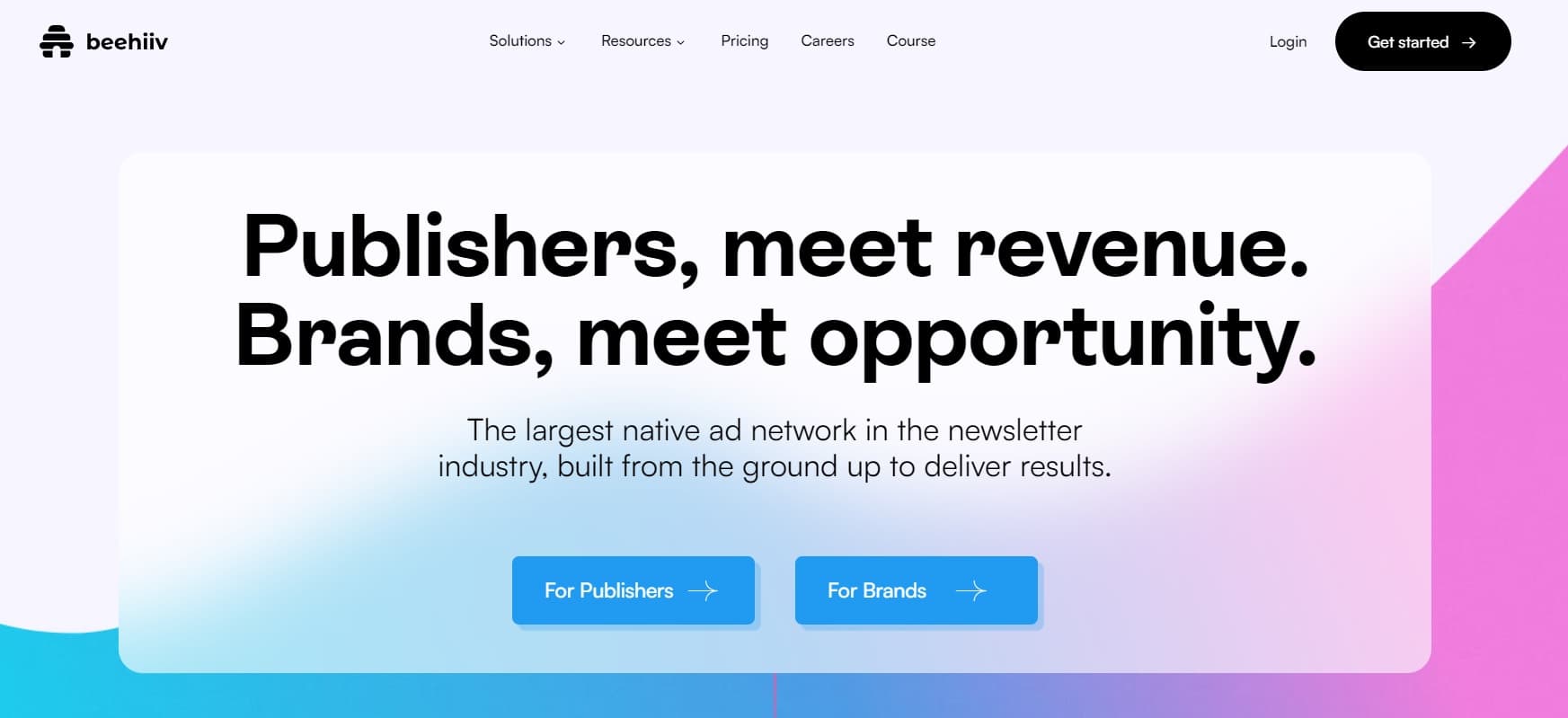 The beehiiv.com home page © Beehiiv
The beehiiv.com home page © Beehiiv
Beehiiv’s biggest product plans seem to be in the area of advertising, building a programmatic ad network for newsletters. They’re working on matching brands and advertisers to newsletter topics and offering a widening array of formats to insert ads natively. Beehiiv also provides built-in design and editing tools for newsletters and websites, making it easier for creators to produce professional-looking content.
Beehiiv’s biggest product plans seem to be in the area of advertising, building a programmatic ad network for newsletters. They’re working on matching brands and advertisers to newsletter topics and offering a widening array of formats to insert ads natively.
What is Beehiiv's pricing model?
Beehiiv's approach is somewhat different from the other platforms here. For instance, they don't plan to take a cut on subscriptions if creators decide to implement paywalls (though Stripe fees still apply) and ad dollars still seem to be a key feature in their revenue model. But it charges its customers monthly fees, with three usage tiers: free, $42/month, and $84/month.
Smore - great for education
Smore is an online platform that simplifies the creation of newsletters and presentations, and focuses in particular on education and training materials. It provides a variety of visually appealing templates, allowing users to build multimedia content quickly and easily. If used in an educational setting, it's recommended to purchase the education version for access to education-themed clip art and in-depth features.
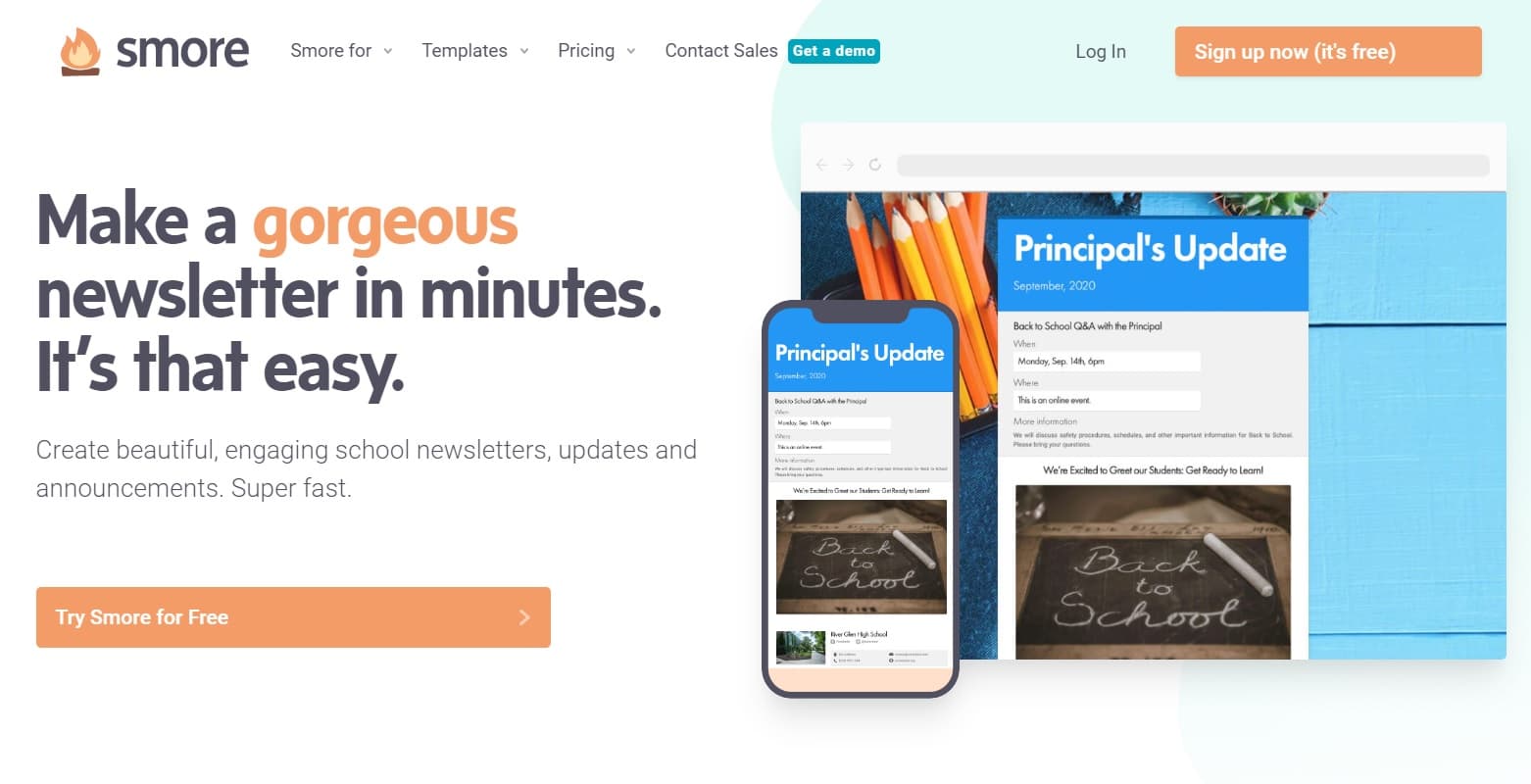 The smore.com home page © Smore
The smore.com home page © Smore
Smore is particularly praised for its user-friendly interface and versatility. Users can easily customize their newsletters with different background images, colors, and fonts. It’s possible to add a wide array of content to the newsletters, including text, images, video content, attachments, forms, audio, and calendar options. Once created, these newsletters can be easily shared on social media or via email through a copied link. Smore also provides analytics, allowing users to track how many views their newsletters have received.
What is Smore's pricing model?
Setting up an account is straightforward with just an email address. You can try the product for free before purchasing. Free accounts come with 5 free 'smores' (creations), while Educator accounts come with unlimited smores. Smore Educator Basic costs $99/year, Smore Educator Pro costs $179/year and Smore Educator Premium costs $299/year.
Memberful - great for membership
We would be remiss if we didn’t mention ourselves! Memberful is membership management software that lets creators manage membership programs with custom price tiers and access levels in order to monetize their content, including paid subscriptions the platform. Memberful works well for online course (eCourse) creators, podcast hosts, and other content creators who want to grow their audience. Similarly, Mighty Networks allows users to build online communities with features like forums and live events, providing creators with tools to foster engagement and collaboration within their audience.
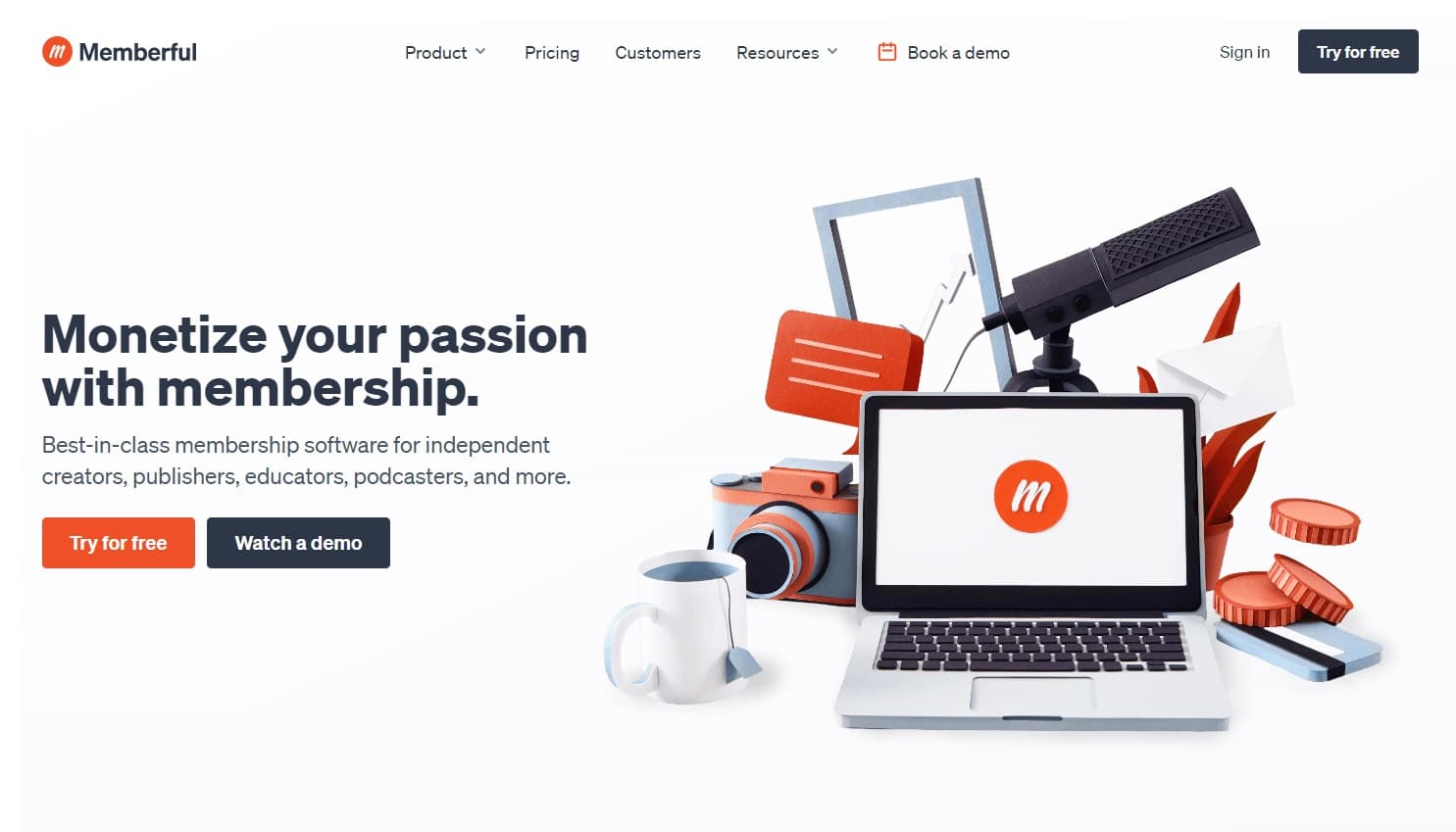 The memberful.com home page
The memberful.com home page
Particularly relevant here is our Posts feature, which replicates Substack’s ‘combined email and online’ approach. Memberful allows you to publish members-only content via newsletter as well as a Memberful-hosted website. You can add text and images, select which of your members to target, and publish the post or schedule it for later. Go to our help docs for more information. Memberful also integrates with Stripe, enabling creators to monetize newsletters with paid subscriptions.
What is Memberful's pricing model?
We offer a simple, all-access pricing: you can use everything Memberful has to offer, including our Posts feature, for one price of $49/month plus a transaction fee of 4.9% per successful charge. We use Stripe for processing payments, which also charges a credit card processing fee that varies by country.
This price allows for unlimited membership plans and unlimited members, plus all integrations. Try it for free for as long as you like. You'll only be charged when you go live and start accepting payments.
Newsletter Platform Comparison
Comparing different newsletter platforms can help creators choose the best platform for their needs. Factors to consider include the platform’s features, pricing, and customization options. Some platforms offer more advanced features such as automation workflows, affiliate management, and AI personalization, while others provide a more minimalist interface and a free version with limited features.
For example, platforms like Kit and Mailchimp offer a range of advanced features, including email marketing automation, segmentation, and analytics. These tools can help creators optimize their campaigns and better connect with their audience. On the other hand, platforms like Ghost and Medium provide a more streamlined and user-friendly interface, focusing on writing and publishing. By comparing these factors, creators can find a platform that aligns with their goals and preferences.
Comparison of Top Platforms
A comparison of top newsletter platforms reveals that some platforms, such as Substack alternatives, offer more advanced features and customization options, while others provide a more streamlined and user-friendly interface. Platforms like Mailchimp and Kit offer a range of features including email marketing automation, segmentation, and analytics, making them ideal for creators who need robust marketing tools.
In contrast, platforms like Ghost and Medium focus on providing a minimalist interface and a strong emphasis on writing and publishing. These platforms are perfect for creators who prioritize content creation over complex marketing features. Ultimately, the best platform for a creator will depend on their specific needs and goals, including their monetization strategies, SEO requirements, and customization preferences. By carefully evaluating these factors, creators can choose a platform that best supports their growth and success.
Substack alternatives - FAQs (Frequently Asked Questions)
What is Substack?
Substack lets digital writers set up their own publication and offer subscription plans to their readers, in return for exclusive updates and newsletter/online content.
What are the advantages of using a Substack alternative?
Substack competitors often offer unique features such as different subscription models, enhanced analytics, and customization options. HubSpot's full stack software is a comprehensive solution for marketing, sales, and content management, making it convenient for users familiar with HubSpot's ecosystem. These platforms can give creators more control over their content and revenue streams.
Is it possible to switch from Substack to a competitor?
Yes, it is possible to switch from Substack to a competitor platform. Most platforms offer tools to import your subscribers and content seamlessly. However, it's essential to communicate the transition to your subscribers to avoid confusion.
Are there any free alternatives to Substack and its competitors?
Yes, there are free alternatives to Substack and its competitors, such as Medium. These platforms often have basic features and may display ads to support their free services. Creators looking to start without financial commitment can explore these options.
Conclusion - What is Substack and who are Substack's competitors?
There's a great choice for someone looking for Substack competitors: there's raft of platfroms that let you publish and distribute email ewsletters to an audience, and to create revenue for doing so.
Whether you're more interested in a platfrom that focuses on email, or community publishing or membership, or something else, will depend on the type of content you want to create, as well as factors such as the frequency of your publishing and your desired level of customization.
Remember, it's not just about distributing content -- it's about offering value, building relationships, and continuously evolving your approach. We hope that this helps - happy publishing!
Subscribe for updates
Stay up to date on Memberful's latest product updates, insights, and teaching centered around growing your community.
Have an audience?
Customers like Mythical (28+ million subscribers) rely on Memberful to power their membership communities.
Get started for free